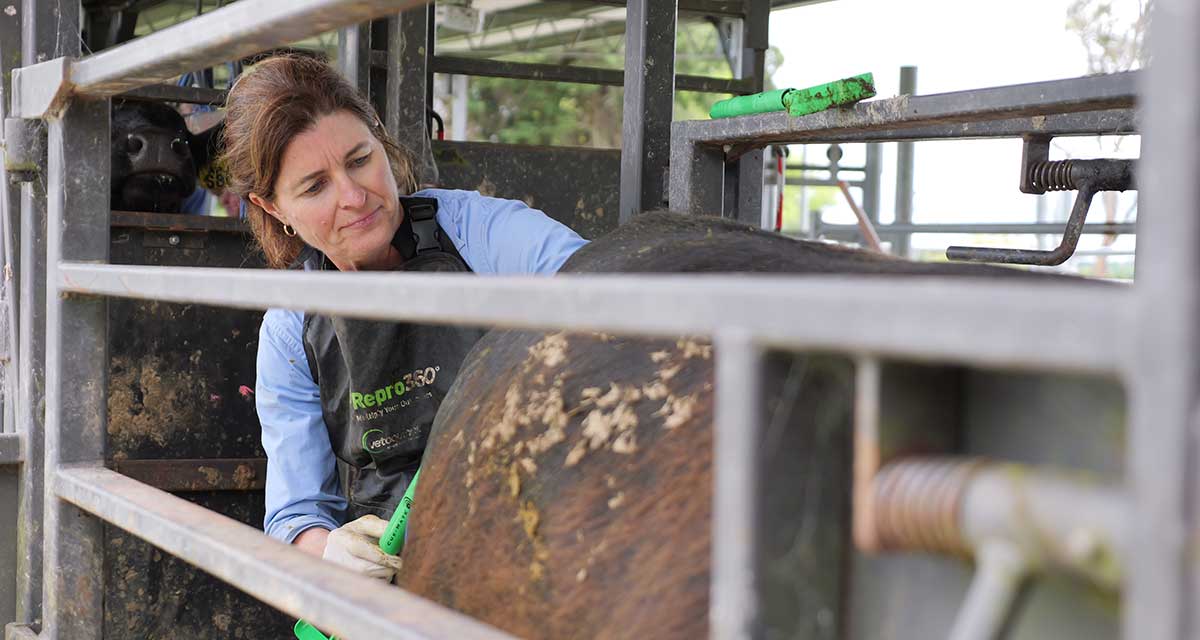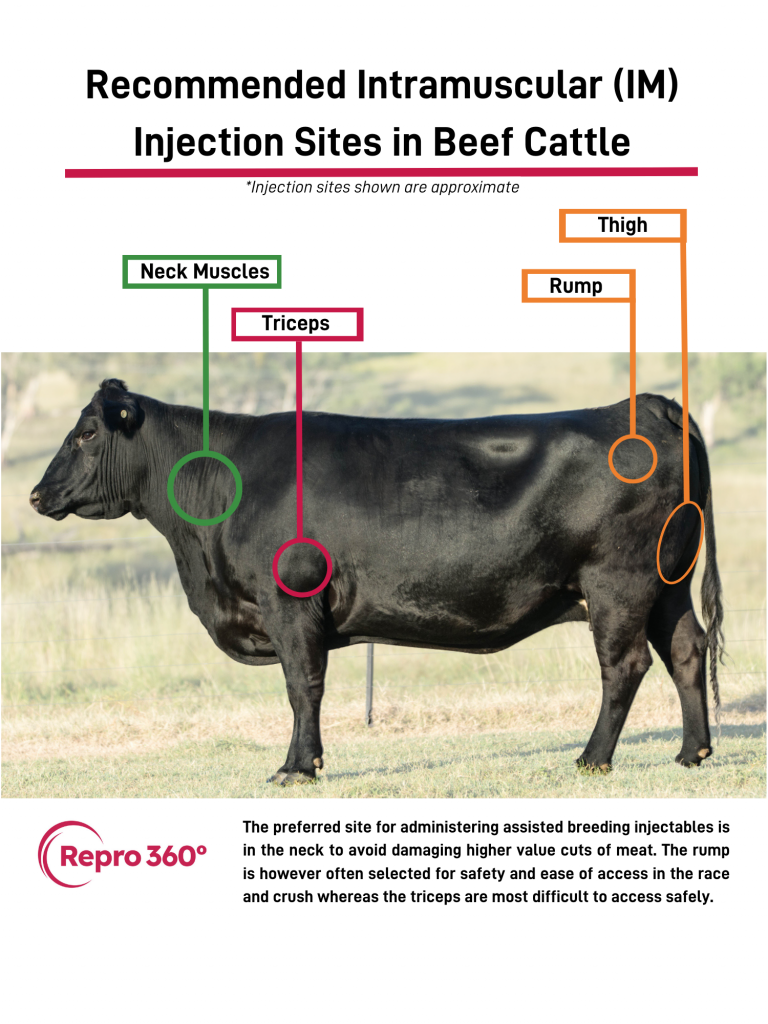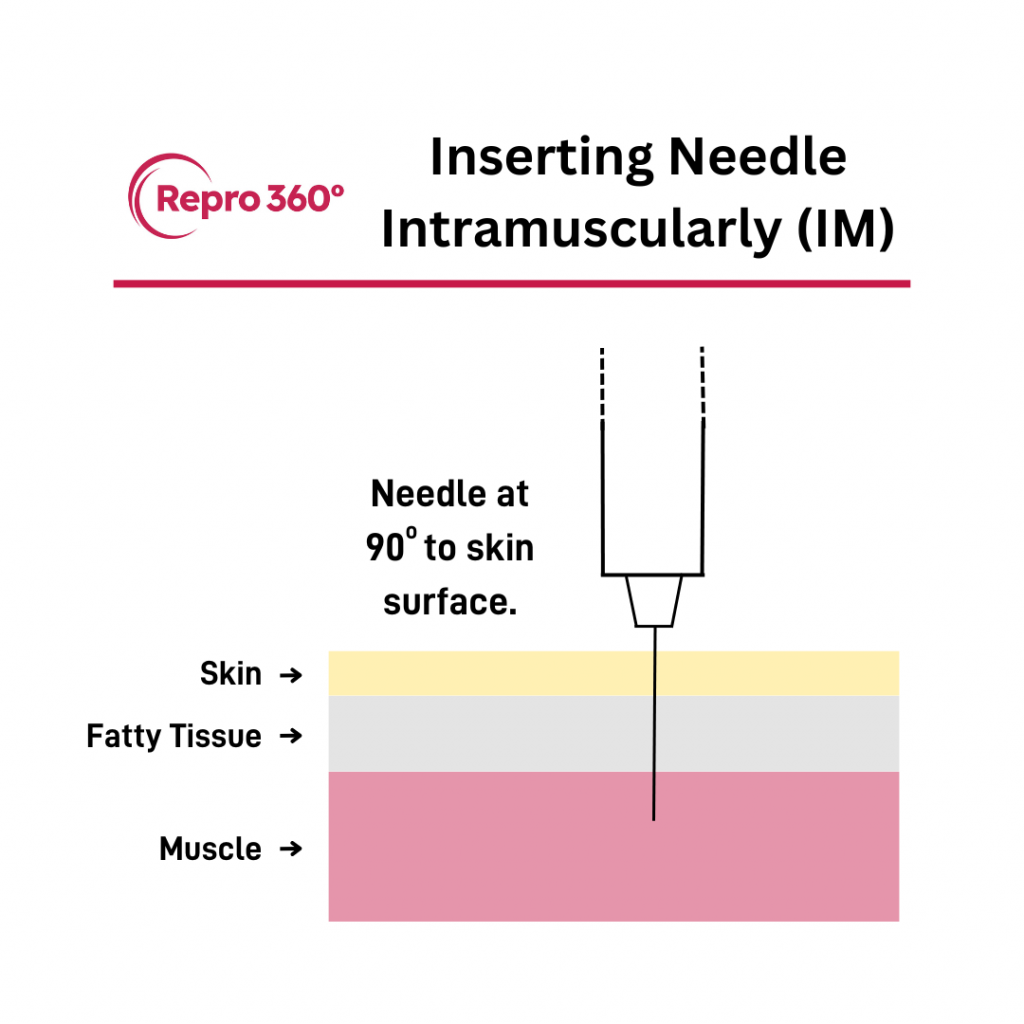Repro Injectables – how to avoid costly mistakes


An important component of maximising results from an assisted breeding program is ensuring injectables are managed correctly. All too often, hormones such as prostaglandin (PG), Gonadotropin releasing hormone (GnRH), follicle stimulating hormone (FSH) and oestradiol benzoate (ODB) are administered either incorrectly or on the wrong day, at the wrong time or at the wrong dose. It is believed that up to 30% of producers could improve their results by following best practice management.
This article is aimed at helping minimise the risk of errors occurring and thereby helping ensure the maximum pregnancy rate is achieved from your investment in artificial insemination (AI) or embryo transfer (ET).
Route of Administration
The good thing about the injectables needed for assisted breeding programs, is that they are all administered intramuscularly (IM), i.e. directly into the muscle rather than intravenously (IV) or subcutaneously (SC).
The preferred site to give IM injections, particularly in beef cattle is directly into the neck muscles to avoid damage to the higher value hindquarter cuts of meat (and minimise the risk of damaging the sciatic nerve). However, given injectables are often administered in the race rather than the crush, it may be safer and more practical to administer these into the rump and thigh muscles as shown in Figure 1.
If the females are in very good body condition score, sometimes the depth of the fat on the rump may exceed the length of the needle. If this is a concern, selecting an injection site on the female that has less fat cover such as the neck or the lower thigh may be more suitable. Safety must always be considered before choosing these sites.
Dosage
Reproduction treatments are administered in small doses; usually 1 mL or 2 mL at a time. It is therefore critical to ensure that the full dose is administered to have the necessary effect on the female’s reproductive cycle. The right equipment, the right settings and correct technique will help minimise errors.
Two of the most common mistakes are incorrectly setting the dosage on flexi-dose injector guns and pulling out the needle out before the hormones have been completely administered, meaning an animal is likely to receive less than the recommended dose. Taking a few more seconds with each injection to ensure it has been fully dispensed into the muscle is worthwhile; particularly when using slapshots and more viscous products such as ODB.
Equipment
Injector Guns
Given relatively large numbers of females tend to be synchronised at any one time, injector guns are much quicker, easier and safer to use than drawing up the correct dose in a syringe.

While injector guns are available in fixed and flexi dose forms, flexi dose guns tend to be more popular in Australia. Vetoquinol has introduced blue flexi guns for PG which is typically administered in 2 mL doses and green guns for GnRH which is generally administered as a 1 mL dose (Figure 2).
Regardless of the gun used, it is important to check the dose each time (and regularly if treating larger mobs of females) to ensure not only the setting is correct but that there are no air bubbles or blockages. It is advisable to use different guns for each product to ensure different hormones aren’t combined.
 Slapshot tubing
Slapshot tubing
Slapshot tubing is recommended for both convenience and safety. This is often 1m in length and has the added advantage of enabling the needle to safely stay in the animal for a few seconds longer to ensure the full dose has been administered. It also means that less needles are bent and less injury to the operator administering the treatments.
Bottle Mounts
Bottle mounts are often added to the gun (as seen above) to protect the bottle whilst eliminating the need to draw up the required dose each time. Ensure when placing the bottle on the injector guns, that the seal between the gun and the product is neat to avoid any leakage. This is not only wasteful and could leave you short for the program but may also be harmful to the operator if contact is made with the skin.
Needles
Selecting the right sized needle is important. DO NOT use the same needles as you do for administering vaccines – these are designed for subcutaneous injections and are too short. Needles should be at least an inch long (2.5cm). On the other hand, if they are too long (i.e. 1.5 inches) they are more likely to bend or break. 22-gauge needles are standard for non-viscous assisted breeding drugs including PG, GnRH and FSH whereas 18-gauge needles are preferable for the more viscous ODB.
Needles should be long and strong enough to pass at a 90-degree angle through the skin and fatty tissue and sufficiently far enough into the muscle for maximum efficacy. Needles should be changed regularly. How often will vary depending on many factors such as the administration site, age of the animal, thickness of the hide and technique.

Timing
The timing of hormone administration is critical for the success of an AI or ET program. Forgetting a treatment or being out by a few hours can be the difference between success and failure. Taking the time during the planning stage to add calendar reminders and phone alerts is highly recommended. It is also important to ensure that the whole team handling the livestock in the yards is made aware of the timing and correct drugs and doses to be used prior to the program. Teams that operate well in the yards and are well informed about the program in advance are more likely to have superior results.
Storage
Given temperatures in Australia are often above room temperature or 30°C (which is the standard requirement for most hormones) during peak breeding season, Vetoquinol recommends that all products should be kept refrigerated to retain their efficacy. On the day of administration, vials should be kept in an esky with an ice pack until they are ready to be used. Injectables should never be frozen and always stored out of direct sunlight.
Disposal
It is always best practice to check the label indications regarding disposal for each product. Any unused product should be discarded 28 days after first broaching the vial. The preferred method of disposal is by ensuring needles are placed in a sharps disposal container and wrapping the vials in paper for disposal in general waste.
Beware
Given hormones can be absorbed through the skin, care should be taken and protective gloves worn when handling all products containing natural or synthetic hormones. This is particularly important for asthmatics and women of childbearing age using PG. Always wash your hands after administering injectables.
If any product is accidentally spilt on the skin, it should be immediately washed off with water. Repeated exposure may cause allergic disorders.
Summary
We’re human and we make mistakes. HOWEVER the most common mistakes in assisted breeding programs are avoidable. Planning and Preparation = Pregnancies
Article supplied by Repro360, sponsored by Vetoquinol Australia. For more information, contact the Repro360 Team on 1300 163 056 or visit repro360.com.au. Alternatively learn more about assisted breeding by following Repro360 on YouTube and listening to the Making Better Bovine Babies podcast.